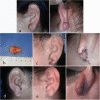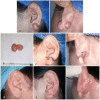Outcomes of Surgical Excision and High-Dose-Rate Brachytherapy for Earlobe Keloids
- PMID: 33833958
- PMCID: PMC8016371
- DOI: 10.29252/wjps.10.1.78
Outcomes of Surgical Excision and High-Dose-Rate Brachytherapy for Earlobe Keloids
Abstract
Background: Radiotherapy as an adjuvant therapy to surgical resection has shown variable rates of recurrence treating earlobe keloids. The purpose of this study was to describe our experience with surgical excision followed by high-dose-rate brachytherapy and present our outcomes after 24 months of follow-up.
Methods: Retrospective chart of 14 patients with 14 earlobe keloids treated with surgical excision followed by high-dose-rate brachytherapy, between January 2015 and May 2016 were enrolled. Database included demographics, Fitzpatrick skin type, laterality, lesion size, and follow-up visits information. Outcomes were assessed in terms of keloid recurrence rates, complications, and patient subjective aesthetical result satisfaction after 24 months of follow-up.
Results: All procedures were completed without complications. Three patients experienced keloid recurrence after 6 (14.28%) and 12 months (7.14%). Three patients experienced mild signs of self-limited post-radiation dermatitis. Self-assessment of aesthetical result was considered "very good" in 71.43% of patients.
Conclusion: Surgical excision followed by high-dose-rate brachytherapy is secure and effective to treat earlobe keloids, and can be considered a first line combined treatment. Larger clinical trials comparing different irradiation protocols are still needed.
Keywords: Earlobe keloid; Excision; High-dose-rate brachytherapy; Plastic surgery.
Figures


Similar articles
-
Efficacy and Safety of Excision Combination Therapies for Earlobe Keloids: A Systematic Review and Meta-analysis.Aesthetic Plast Surg. 2024 Aug;48(15):2757-2770. doi: 10.1007/s00266-024-04092-0. Epub 2024 May 24. Aesthetic Plast Surg. 2024. PMID: 38789810
-
Experience Treating Earlobe Keloids with Laser Diode 980nm Excision Followed by Triamcinolone Infiltration.Lasers Surg Med. 2021 Apr;53(4):468-475. doi: 10.1002/lsm.23310. Epub 2020 Aug 22. Lasers Surg Med. 2021. PMID: 32827340
-
Surgical Excision and Adjuvant Brachytherapy vs External Beam Radiation for the Effective Treatment of Keloids: 10-Year Institutional Retrospective Analysis.Aesthet Surg J. 2017 Feb;37(2):212-225. doi: 10.1093/asj/sjw124. Epub 2016 Aug 23. Aesthet Surg J. 2017. PMID: 27553611
-
Treatment of earlobe keloids by extralesional excision combined with preoperative and postoperative "sandwich" radiotherapy.Plast Reconstr Surg. 2010 Jan;125(1):135-141. doi: 10.1097/PRS.0b013e3181c2a46e. Plast Reconstr Surg. 2010. PMID: 20048606
-
Association of surgical excision and brachytherapy for the management of keloids.J Stomatol Oral Maxillofac Surg. 2017 Jun;118(3):161-166. doi: 10.1016/j.jormas.2017.04.002. Epub 2017 Apr 8. J Stomatol Oral Maxillofac Surg. 2017. PMID: 28400319 Review.
Cited by
-
Should We Do Postoperative Radiotherapy After Keloid Excision as Soon as Possible? A Systematic Review and Meta-Analysis.Aesthetic Plast Surg. 2025 May 9. doi: 10.1007/s00266-025-04869-x. Online ahead of print. Aesthetic Plast Surg. 2025. PMID: 40346340 Review.
-
Efficacy and Safety of Excision Combination Therapies for Earlobe Keloids: A Systematic Review and Meta-analysis.Aesthetic Plast Surg. 2024 Aug;48(15):2757-2770. doi: 10.1007/s00266-024-04092-0. Epub 2024 May 24. Aesthetic Plast Surg. 2024. PMID: 38789810
-
Current advances in the selection of adjuvant radiotherapy regimens for keloid.Front Med (Lausanne). 2022 Nov 8;9:1043840. doi: 10.3389/fmed.2022.1043840. eCollection 2022. Front Med (Lausanne). 2022. PMID: 36425105 Free PMC article. Review.
-
Surgery and superficial x-ray radiotherapy for keloids of the preauricular and contralateral ear lobe: Case report.Clin Case Rep. 2024 Mar 29;12(4):e8657. doi: 10.1002/ccr3.8657. eCollection 2024 Apr. Clin Case Rep. 2024. PMID: 38560287 Free PMC article.
References
-
- Younai S, Nichter LS, Wellisz T, Reinisch J, Nimni ME, Tuan TL. Modulation of collagen synthesis by transforming growth factor-beta in keloid and hypertrophic scar fibroblasts. Ann Plast Surg. 1994;33:148–51. - PubMed
-
- Mustoe TA, Cooter RD, Gold MH, Hobbs FD, Ramelet AA, Shakespeare PG, Stella M, Teot L, Wood FM, Ziegler UE. International Advisory Panel on Scar M International clinical recommendations on scar management. Plast Reconstr Surg. 2002;110:560–71. - PubMed
LinkOut - more resources
Full Text Sources
Other Literature Sources
